Use of Amphibian Communities as Indicators of Restoration Success in the Everglades
Authors
Amanda N. Rice, J. Hardin Waddle, Kenneth G. Rice, and Frank J. Mazzotti
Introduction
The Comprehensive Everglades Restoration Plan (CERP) requires the use of indicator species to measure the success of restoration efforts. The Everglades amphibian community is an ideal indicator because amphibians are present in all habitats and under all hydrologic regimes in the Everglades. The hydropattern in the Everglades, the amphibian biphasic life-cycle, and individual species requirements are all responsible for the distinct pattern of amphibian communities across habitats.
We have developed two major projects that use amphibian communities as ecosystem restoration indicators. The first project, completed in 2003, was an inventory of amphibian communities in Everglades National Park, Biscayne National Park, and Big Cypress National Preserve. This project established baseline data for amphibian communities in the study areas and elucidated habitat and hydrologic associations of the amphibian species. The second project, currently underway, is investigating amphibian communities across the hydrologic gradient in the Everglades. This project will define and measure the membership and area occupancy of amphibian communities in habitats with different hydropatterns, thus allowing managers to evaluate Everglades restoration efforts, establish restoration targets, and compare restoration alternatives.
 |
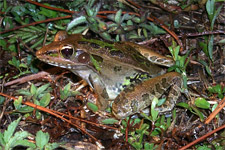 |
| Florida Cricket frog (Acris gryllus) on lily pad in WCA 3A. | Southern Leopard Frog (Rana sphenocephala) |
Methods
Both projects used randomly selected plots to obtain data on amphibians. Three sampling methods were used to inventory amphibians, including Anuran Vocalization Surveys, Visual Encounter Surveys, and Trapping. Vocalization surveys and Visual encounter surveys are conducted at night.
Anuran Vocalization Surveys
At each randomly chosen plot, frogs and toads heard vocalizing for 10 minutes were noted in categories of abundance and frequency.
Abundance of vocalizing frogs and toads were put into one of five possible categories:
- One individual calling
- 2-5 individuals
- 6-10 individuals
- > 10 individuals, or Large chorus
Frequency of vocalizing frogs were put into one of three categories:
- Occasional
- Frequent
- Continuous
Visual Encounter Surveys
At each randomly chosen plot, amphibians are surveyed for 30 minutes.
Amphibians detected are identified to species.
Amphibians are captured if possible, measured and weighed.
Trapping
Amphibians were trapped using two types of funnel traps: crayfish and minnow.
In addition, PVC pipe refugia were used to trap treefrogs.
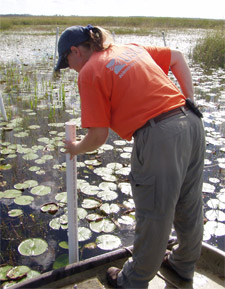 |
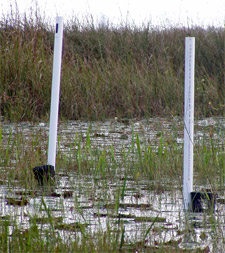 |
| Checking PVC pipe refugia in WCA 3B | PVC pipes with crayfish trap attached |
Inventory of Amphbian Communities in Everglades National Park
This study was conducted from 2000 to 2003. Goals of the project were to create a georeferenced inventory of amphibian species, use new analytical techniques to estimate proportion of sites occupied by each species, look for any signs of amphibian decline (missing species, disease, die-offs, etc.), and establish a protocol that could be used for future monitoring efforts.
Results from our amphibians surveys and trapping throughout Everglades National Park were used to estimate the proportion of sites or proportion of area occupied (PAO) by each amphibian species in each habitat.
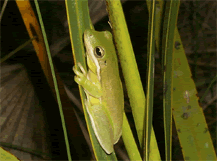
Green Treefrog (Hyla cinerea)
Months in 2001 during which Hyla cinerea was detected by VES methods and vocalization
| Month | VES | Vocalization |
|---|---|---|
| Jan | X | |
| Feb | X | |
| Mar | X | X |
| Apr | X | X |
| May | X | X |
| June | X | X |
| July | X | X |
| Aug | X | X |
| Sept | X | X |
| Oct | X | |
| Nov | X | |
| Dec | X |
Number of sites sampled, sites at which Hyla cinerea was detected, and the na´ve site occupancy rate by habitat
| Habitat | Number of Sites | Number of Sites with Detection | Naive Occupancy Rate | PAO Estimate |
|---|---|---|---|---|
| Cypress | 16 | 13 | 81.3% | 90.15% |
| Hammock | 14 | 12 | 85.7% | 95.62% |
| Mangrove | 16 | 7 | 43.8% | 48.82% |
| Pineland | 17 | 15 | 88.2% | 95.44% |
| Rocky Glades | 18 | 16 | 88.9% | 99.09% |
| Slough | 29 | 29 | 100.0% | 100.00% |
| Borrow Pit/ Canal | 4 | 3 | 75.0% | N/A |
| Building/ Road | 4 | 3 | 75.0% | N/A |
| Total | 118 | 98 | 83.1% | 88.23% |
Results of this study are in report form and available on CD-ROM:
Rice, K.G., J.H. Waddle, M.E. Crocket, B.M. Jeffery, and H.F. Percival., 2004. Herpetofaunal Inventory of the National Parks of South Florida and the Caribbean: Volume 1. Everglades National Park. U.S. Geological Survey, Open-File Report 2004-2005, Fort Lauderdale, Florida.
Use of Amphibian Communities as Indicators of Restoration Success Across Hydrologic Gradients
In this study, amphibian communities are being investigated in four habitats with different hydropatterns. This study will produce a model of amphibian community patterns across hydrologic gradients and will allow managers to measure restoration success.
Hydropattern of each site in this study. Each site contains five plots
| Site | Number of Days With Standing Water |
|---|---|
| Main Park Road | 95* |
| Context Road | 201* |
| WCA 3B | 342* |
| WCA 3A | 365* |
| * 10 year average | |
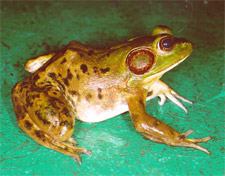
Pig frog (Rana grylio)
| Species | Number Trapped | Trap Type | Site* |
|---|---|---|---|
| Green treefrog Hyla cinerea | 102 | PVC | MPR, CR, 3A, 3B |
| Squirrel treefrog Hyla squirella | 81 | PVC | MPR, CR |
| Squirrel treefrog Hyla squirella | 1 | Minnow | CR |
| Leopard frog Rana sphenocephala | 6 | Minnow | CR |
| Pig frog Rana grylio | 1 (adult) - 4 (tadpoles) | Crayfish | 3A, 3B |
| Oak toad Bufo quercicus | 1 | Minnow | MPR |
| Peninsular newt Notophalmus viridescens priapicola | 1 | Crayfish | 3A |
| Greater siren Siren lacertina | 7 | Crayfish | 3A, 3B |
| Florida green water snake Nerodia floridana | 4 | Crayfish | 3A |
| Striped crayfish snake Regina alleni | 1 | Minnow | MPR |
| Green anole Anolis carolinensis | 3 | Minnow | CR |
| * MPR = Main Park Road site, CR = Context Road site, 3A = WCA 3A site, and 3B = WCA 3B site | |||
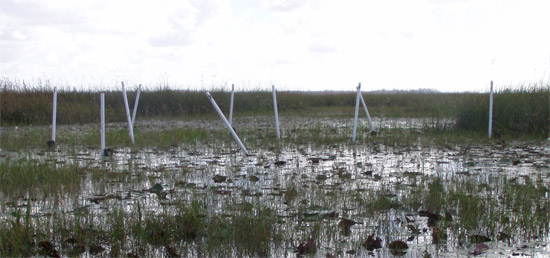
This is plot 20 in WCA 3B. Here we listen for frog calls, visually search for amphibians, and trap using crayfish traps and PVC pipes. Frogs commonly heard here are green treefrogs (Hyla cinerea), pig frogs (Rana grylio), Florida cricket frogs (Acris gryllus), and southern leopard frogs (Rana schenocephala).
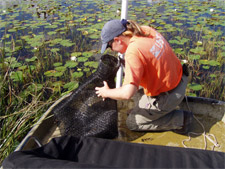
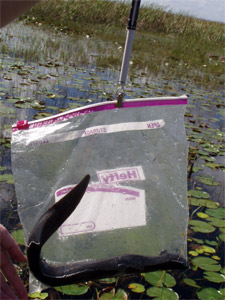
The purpose of trapping at sites 3A and 3B is to catch aquatic salamanders such as the greater siren (Siren lacertina). The greater sirens captured are measured, weighed and released.
Citation
Rice, A.N., J.H. Waddle, K.G. Rice, and F.J. Mazzotti. (2004, December). Use of Amphibian Communities as Indicators of Restoration Success in the Everglades. Poster presented at the National Conference on Ecosystem Restoration, Orlando, Florida.




